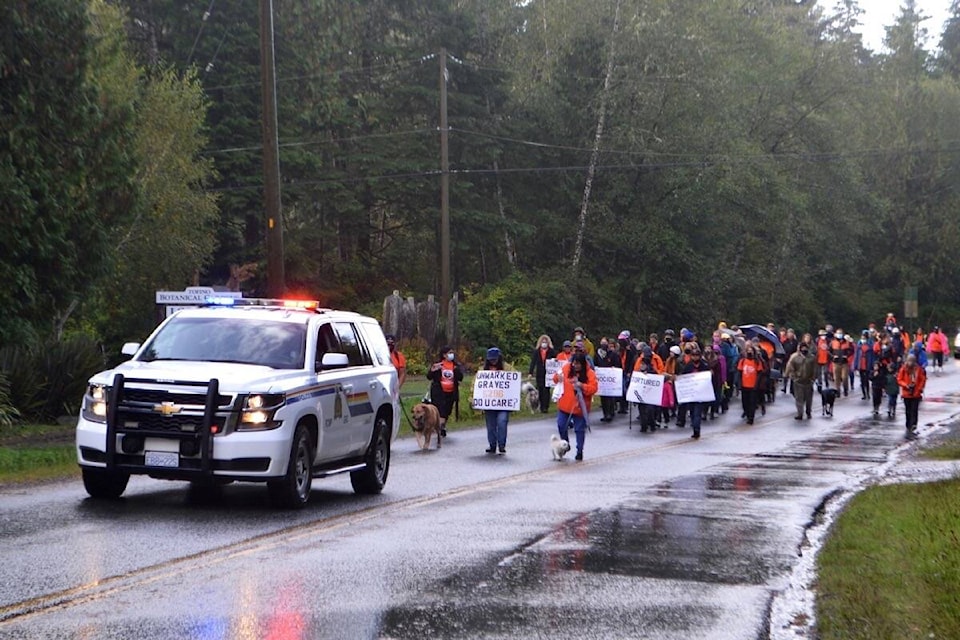Bouts of rain would help wash away the tears during a somber procession from Tin Wis Resort to Tofino’s Village Green on Sept. 30 to mark Canada’s first National Day for Truth and Reconciliation.
There was no chanting and no traditional drumming.
Tla-o-qui-aht First Nation Chief Moses Martin opened up the special day of reflection with two minutes and 15 seconds of silence to commemorate the unmarked graves of 215 children found in late May 2021 at the former Kamloops Indian Residential School.
Martin called the day both frustrating and hopeful.
“It’s frustrating because this is a story that’s been told for generations. Frustrating for people like myself that are trying to find ways to help our people get through some of these issues that have to deal with; the trauma from the residential school days,” he said.
“But hopeful also that the Canadian people will begin to open up their minds, open up your hearts, and listen to the stories that we have to tell,” said Chief Martin.
Tofino Mayor Dan Law said a National Day for Truth and Reconciliation has been a long time coming.
“Now is the time to listen. I encourage everyone to listen to understand so that the stories go inside deep and start to change us as a community, as a province, and as a nation,” said Law.
Mariah Charleson of Hesquiaht First Nation speaks about learning the true history of Canada.
Nuu-chah-nulth Tribal Council vice president Mariah Charleson said that Truth and Reconciliation is about reflection, acknowledgement and learning Canada’s true history.
“Thousands and thousands of tourists come and visit Tla-o-qui-aht Ha-Hoothlee (territory) every single year. I would like to know how many of those tourists leave this place knowing that true history? Knowing what happened right here. Knowing what impacted all of the Nations around Tla-o-qui-aht, Hesquiaht, Ahousaht… All of our Nations in Nuu-chah-nulth have been directly impacted by the Indian residential school system,” said Charleson.
There were three residential schools in the West Coast region: Ahousaht Residential School in Ahousaht First Nations territory on Flores Island (1904 -1940), Christie Residential School in Ahousaht and Tla-o-qui-aht First Nations territories, Tofino/Meares Island (1900 -1983), and Alberni Indian Residential School in Tseshaht First Nations territory, Port Alberni (1900 -1973).
Tla-o-qui-aht Community Health liaison Nora Martin is a survivor of the Alberni Indian Residential School. During the Sept. 30 rally, she led an emotional theatrical performance alongside survivors Grace Frank, Alice George, Larry Baird, Tom Curley, Carol Manson, Rose Tom and Cecilia Jackson.
“What we are dealing with is really hard, but I’m really grateful to see all the people here showing their love and support to us and being so kind. I’m really amazed with your help and generosity to make this a success,” Martin told the audience after the haunting enactment of what took place at Indian Residential Schools.
“Hopefully going down the road we can work together to help make these changes. We all have to pull together to save this planet because ultimately that is what it was all about was to annihilate us to take over the resources,” she said.
Nora Martin of Tla-o-qui-aht First Nation directs a chilling skit about Indian Residential Schools.
Ford and Linda Cannon from Port Alberni walk the 'Road to Reconciliation'.
Port Alberni residents Ford and Linda Cannon got up early and drove to Tofino to participate in the rally. The Cannons are members of the Alberni United Church and host a ‘Road to Reconciliation’ meeting every Sunday for IRS survivors and parishioners.
“I’m abundantly ashamed of my ancestors. I never had an occasion to feel that way before, but I am abundantly, and myself too because I didn’t know any better,” said Cannon, who at 73, only just started to learn about the Canadian Residential School System within the last decade.
“The Caucasian community has to clearly, unabashedly admit that the problem is ours, not the problem of the Indigenous peoples, it’s ours and we have to do something about it. And that’s and educational thing as well,” said Ford during the walk.
“As they say, doing is more than wearing orange shirts,” Linda went on to note.
Nuu-chah-nulth education worker Jason Sam stands amid the Legacy of Hope Foundation museum exhibit.
At the Ucluelet Secondary School, Nuu-chah-nulth education worker Jason Sam was busy hosting ‘Escaping Residential Schools: Running for Their Lives’, a museum exhibit on loan from the Legacy of Hope Foundation. He said 206 people showed up for the public opening and over the course of 10 days, 250 to 300 students and staff attended as well.
“The culmination of a long project and a lot of hard work was very well received. All the comments were very positive and everyone was very grateful. We were doing this as a community,” he said.
Sam encouraged West Coasters to keep educating themselves, especially about the Truth and Reconciliation Commission’s 94 Calls to Action.
“And keep having those conversations,” he said.
RELATED: Justin Trudeau spends National Day for Truth and Reconciliation with family in Tofino
nora.omalley@westerlynews.ca
Like us on Facebook and follow us on Twitter
READ: ‘In awe’: National Day for Truth and Reconciliation huge for Orange Shirt Day founders
